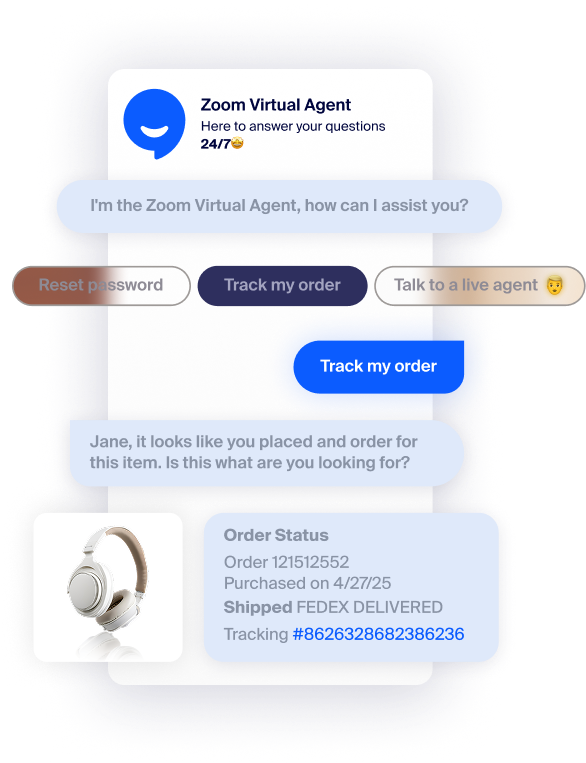
Frost & Sullivan: Is AI in customer service the missing link to lasting brand loyalty?
Explore how AI in customer service transforms customer experience and builds lasting brand loyalty. Download Frost & Sullivan's vBook today.
It’s time to move beyond basic chatbots and embrace specialized AI virtual agents that take real action for your customers.
Updated on June 13, 2025
Published on June 11, 2025


Customer expectations have never been higher, and businesses are feeling it. As consumers, we want a fast resolution to product or service issues when and where they arise. Anything less only leads to unnecessary frustration. Meeting these standards isn’t just vital; it’s what separates thriving brands from struggling ones. That’s where the power of AI comes in.
But while AI has incredible potential for customer experience (CX) transformation, simply implementing it isn’t enough. Many companies are falling short, frustrating customers and agents alike.
In this post, we bring you into the era of agentic AI. We explore the shift from reactive chatbots that follow scripts to intelligent AI agents that reason, adapt, and act to solve complex challenges autonomously. Plus, we’ll share how Zoom brings agentic AI to life through the next evolution of Zoom Virtual Agent — an always-on, and proactive self-service solution that doesn’t just respond, but acts with purpose to solve customer needs.
Read on to learn how agentic AI can not only help build stronger customer connections but also scale your contact center operations and deliver tangible business outcomes. Think faster resolutions, lower costs, and happier customers.
From automation to connection: The new era of AI-enhanced CX
Did you know that customers will walk away from a brand after just one or two negative experiences? In a 2024 survey by Zoom, 63% of respondents said they would. Think about that for a second. All the time and money you’ve spent acquiring new customers can be undone by just one or two missteps.
At the same time, consumers have more choices than ever before. Clever advertising and marketing are no longer enough to build lasting loyalty. It’s much more likely to be earned through every text, call, and chat with your brand. Every time you let a customer know their order has shipped or you answer their inquiry within minutes, you’re laying the foundation for a long-lasting relationship. Loyalty-building is where AI, when used effectively, can make an undeniable impact. It allows businesses to:
But here’s the challenge: The way many organizations leverage AI today is outdated, leading to missed opportunities and disconnection. What’s the problem? It all comes down to the HOW of AI implementation.
If you’ve started integrating AI into your CX strategy, you might have already faced some of these frustrations along the way:
These irritations disappoint customers and end up weighing down your teams. Agents face repetitive tasks and inconsistent data. Supervisors struggle to track performance holistically, while CX leaders lose the ability to come up with scalable strategies.
The result? Businesses fail to benefit from the efficiency and satisfaction improvements AI promised, only to be left with a costly bill. The good news: we’re entering a new era that clears the path forward and helps you with your AI implementation woes.
To deliver what customers actually want, businesses need to go beyond traditional self-service methods. The future lies in smart, connected, and action-driven AI self-service solutions. Here’s how this new era of AI can transform CX for the better:
1. From automation to connection
Modern AI has moved beyond static chatbots. Today’s intelligent systems perform sophisticated tasks across channels, including voice, chat, and email. They don’t just answer questions; they can recognize patterns, adapt, and improve in real time. This sets the stage for more natural, conversational customer experiences.
In practice, this is how it could work for a restaurant: Instead of just listing menu items when a customer calls, an AI self-service solution could reserve a table, email dietary options, and use the opportunity to upsell a dessert. All seamless. All proactive.
2. Agentic AI unlocks new capabilities
The next frontier is agentic AI. This means moving beyond AI that simply supports agents to AI that takes autonomous actions, resolving issues for customers with minimal human involvement. Here’s what sets agentic AI apart:
Perhaps most exciting, agentic AI reduces the need for constant human oversight while delivering faster, scalable results.
CX analysts, such as Mila D’Antonio, predicted the rise of agentic AI earlier this year: “AI agents will become commonplace in CX, integrated within customer engagement platforms and handling low-value tasks autonomously.” It’s a rapid transformation that Gartner backs up with their prediction that agentic AI will resolve 80 percent of common customer service issues without intervention by 2029.
3. Breaking down silos
Your customers expect seamless experiences across channels, or, in other words, a true omnichannel experience. But legacy systems often create fragmented interactions. Businesses can meet customers’ expectations and deliver continuity throughout their journeys by connecting AI platforms across marketing, sales, and operations.
For instance, imagine a customer who starts with a virtual agent query but has more questions. The customer’s query is seamlessly escalated to a call with a live agent—no repeating, no starting over. Post-call, they receive personalized follow-up emails unique to their query and situation. With integrated AI, all these systems work together to enhance the care you provide, turning a stressful interaction into a memorable experience your customer will want to share with others.
What if you could go a step further, leveraging insights from each interaction to continuously improve self-service, with minimal human involvement? This is where the next generation of Zoom Virtual Agent comes in.
At Zoom, we’ve been at the forefront of this agentic AI transformation. The next-generation Zoom Virtual Agent takes CX to the next level. It’s more than a virtual agent; it’s an agentic powerhouse designed for today’s challenges. It delivers:

Rather than just putting out fires, Zoom Virtual Agent goes a step further to help build lasting customer relationships. By integrating with Zoom Quality Management, it can evaluate up to 100% of interactions across multiple channels, surfacing what went wrong and identifying opportunities to optimize each AI agent’s performance. This end-to-end integration is key because everything happens on one unified platform powered by AI. The result is a customer experience that’s consistent, fast, and accurate, which continuously improves over time.
Read more about Zoom Virtual Agent here.
If your business isn’t fully realizing the benefits of AI in your CX strategy, ask yourself:
The right AI can turn around how your business operates, but the time is now. Customers certainly won’t wait. Competitors are moving forward. It’s time to rethink your CX strategy.
Want to learn more about how AI self-service and agentic AI can transform your CX? Our latest webinar dives deep into the biggest challenges CX leaders face today and how Zoom Virtual Agent is changing the game.
Get ready for the new era of CX today. Sign up for the webinar now.